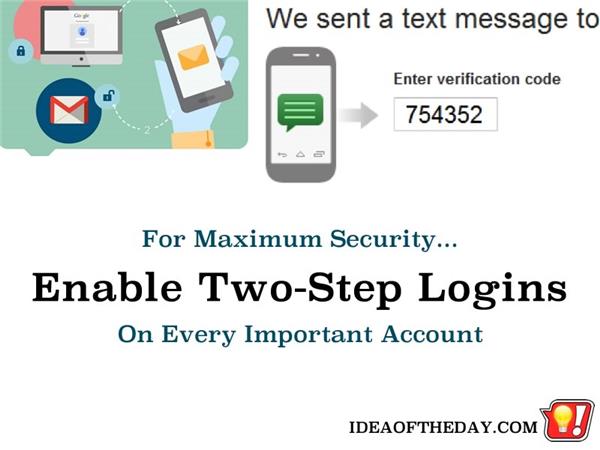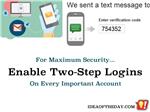Enable Two-Step Login Security on Every Important Account

By
Staten Island, NY Posted: 12/6/2014 1:00:00 AM
A while back, I dig a blog post about avoiding bad passwords, security questions and PIN numbers. Today's post is about an alternative to all three, Two-Step Login Security
As a recap, many people are using passwords, PIN numbers and security questions that are easily guessed. Some of the are so bad, it makes you wonder why so many major corporations use them.
If you were a hacker trying to break into somebody's account and were given one of these security questions... do you think you could hack the account?
"What was the brand of your first car?"
"What's your favorite sports team?"
For "What was the brand of your first car?", even if you don't know, there are truly only a small number of brands. So, after a dozen attempts, at the most, you would clearly find it, even if you've never met the person.
For "Favorite sports team", once you know the city the person lives in, most people pick the home team, so once again, that's a pretty small number of guesses before you hit the right one. Even if you don't know that, chances are you wouldn't take more than a dozen or so attempts to guess.
The bottom line in both cases is there is a very small number of possible answers, so it doesn't take too long to eventually try every possible answer.
What's TWO-STEP Login Security?
Two step logins start off like a regular login, where you enter a password, but after the password, they send a code to your phone every time you log in, then you type that code into your login screen to confirm that you received it.
For example, let's say you want to log into your Gmail account. You put in your ID, then your password, then hit the login button and a message pops up saying "We have just sent your authentication code... please enter it here". If you used a cell phone, a number will pop up on your cell phone, if it's a landline, it will ring and a voice message will read the number to you. Next, you just enter that number on screen and you're done.
The main idea here is that even if you put your Gmail password on a billboard in Times Square, nobody could log into your account, because they would not be able to receive the second code, unless they have also stolen your phone.
Since almost everyone has access to a cell phone 24/7, everyone should enable two step verification on all their major accounts, especially email, iTunes and whenever possible, bank accounts. By effectively blocking third parties from getting into your accounts, you can prevent many types of cyber crimes.
The trick is, many people don't even know that two step is an option, because many don't go out of their way to tell you how to turn it on. I've found that most of the big email services already have it, as does Apple's iTunes, eBay and PayPal. The number of companies and banks supporting two step (sometimes called two factor) authorization is growing every day, so when in doubt, check the security settings on your most important accounts and you may be surprised to find they already support it.
There are some sites that can keep track of companies that support two step logins like this one.
Two step verification has been around in the corporate world for a while now, but it required an employer to issue small devices which had a constantly changing number on them, which could easily be lost. Even if you lose your mobile phone, you can get a replacement in a matter of minutes which insures you will always have the ability to receive the verification codes.
 Joe Crescenzi, Founder
Joe Crescenzi, Founder
Related Media:

(Reply N/A) (Edit Topic N/A)
(Like Topic N/A) [0 ] 7925 Views
Related Posts
Improvements(106)Security(42)Two-Step Security(1)
Top 25 Posts
* Note: The ideas on "Idea of the Day" were posted without any formal research into existing inventions.
In some cases, patents may already exist for these ideas, in other cases, there may not be any existing patents and you are free to develop and explore the viability of developing and patenting the ideas.
The authors make no claim that any of the ideas are safe, practical, or suitable for any particular purpose. You are responsible for the results of trying, developing, patenting or using any of the ideas on this site.
For some people, our ideas are just an interesting read, but our goal is to encourage you to take action. If you see an idea that you like, do something with it... Take action.
- Joe
 on...
on...
 on...
on...